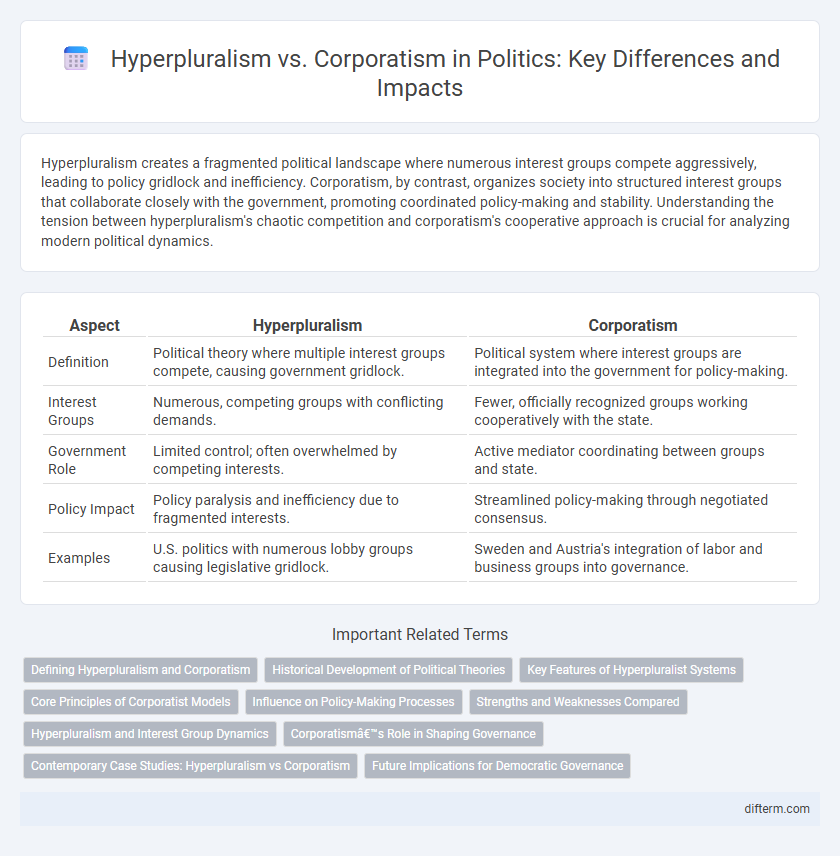Hyperpluralism creates a fragmented political landscape where numerous interest groups compete aggressively, leading to policy gridlock and inefficiency. Corporatism, by contrast, organizes society into structured interest groups that collaborate closely with the government, promoting coordinated policy-making and stability. Understanding the tension between hyperpluralism's chaotic competition and corporatism's cooperative approach is crucial for analyzing modern political dynamics.
Table of Comparison
| Aspect | Hyperpluralism | Corporatism |
|---|---|---|
| Definition | Political theory where multiple interest groups compete, causing government gridlock. | Political system where interest groups are integrated into the government for policy-making. |
| Interest Groups | Numerous, competing groups with conflicting demands. | Fewer, officially recognized groups working cooperatively with the state. |
| Government Role | Limited control; often overwhelmed by competing interests. | Active mediator coordinating between groups and state. |
| Policy Impact | Policy paralysis and inefficiency due to fragmented interests. | Streamlined policy-making through negotiated consensus. |
| Examples | U.S. politics with numerous lobby groups causing legislative gridlock. | Sweden and Austria's integration of labor and business groups into governance. |
Defining Hyperpluralism and Corporatism
Hyperpluralism describes a political system where multiple interest groups exert strong, competing influences, leading to policy gridlock and fragmented governance. Corporatism involves structured collaboration between the state and major interest groups like businesses and labor unions, aiming for coordinated policy decisions that reflect collective interests. Both concepts highlight different mechanisms of interest representation and influence within political decision-making processes.
Historical Development of Political Theories
Hyperpluralism emerged in the mid-20th century as a critique of pluralism, emphasizing the fragmentation of interest groups that leads to governmental gridlock and policy incoherence. Corporatism, with roots tracing back to early 20th-century Europe, advocates structured collaboration between the state, labor, and business sectors to achieve social harmony and streamline policy-making. Both theories reflect evolving responses to societal complexity and the challenges of balancing diverse interest representation in democratic governance.
Key Features of Hyperpluralist Systems
Hyperpluralist systems feature a vast number of competing interest groups that fragment political power, leading to policy gridlock and inefficiency. These systems often exhibit decentralized authority, where diverse groups exert disproportionate influence, weakening coherent policymaking. The result is a diffusion of responsibility and a political environment dominated by conflicting demands that hinder effective governance.
Core Principles of Corporatist Models
Corporatist models are characterized by structured collaboration between the state, labor unions, and business organizations to achieve policy consensus and social integration. The core principles emphasize institutionalized bargaining, representation of organized interests within government frameworks, and the regulation of conflict through negotiated compromise. This model prioritizes stability and cooperation over fragmented competition, contrasting sharply with the hyperpluralism theory where excessive interest group competition leads to political gridlock.
Influence on Policy-Making Processes
Hyperpluralism leads to fragmented policy-making as multiple interest groups compete intensely, causing gridlock and inefficiency within government institutions. Corporatism centralizes influence by integrating key interest groups directly into the policy-making process, resulting in more coordinated and streamlined decision-making. The contrast highlights how hyperpluralism complicates consensus, while corporatism fosters negotiated agreements among select actors.
Strengths and Weaknesses Compared
Hyperpluralism enhances democratic representation by allowing multiple interest groups to influence policymaking, promoting diverse viewpoints and preventing any single entity from dominating. Corporatism centralizes policy negotiation among major interest groups and the government, which can streamline decision-making and achieve more coherent policy outcomes. However, hyperpluralism risks policy gridlock and fragmentation, while corporatism may marginalize smaller groups and reduce pluralistic competition, potentially leading to elite dominance.
Hyperpluralism and Interest Group Dynamics
Hyperpluralism describes a political environment where numerous interest groups wield excessive influence, leading to fragmented policymaking and legislative gridlock. This dynamic intensifies competition among groups, each pursuing narrow agendas that complicate consensus-building and dilute governmental effectiveness. Interest group proliferation under hyperpluralism often results in policy incoherence and challenges to democratic responsiveness.
Corporatism’s Role in Shaping Governance
Corporatism plays a crucial role in shaping governance by organizing society into interest groups that directly participate in policy-making, often leading to structured negotiation between the state and major sectors such as labor, business, and agriculture. This system contrasts with hyperpluralism by promoting cooperation and consensus-building among organized interests rather than producing fragmented and competitive influence. Corporatist arrangements can streamline decision-making processes and enhance stability in governance by institutionalizing collaboration and reducing conflicts among key economic and social stakeholders.
Contemporary Case Studies: Hyperpluralism vs Corporatism
Contemporary case studies highlight the tension between hyperpluralism and corporatism in modern democracies, where hyperpluralism leads to policy gridlock due to competing interest groups exerting fragmented influence. Corporatism, in contrast, channels influence through structured negotiation between state actors and organized interest groups, often resulting in more coherent policy outcomes. For example, Scandinavian countries exhibit corporatist tendencies with institutionalized cooperation, while the United States demonstrates hyperpluralism with diverse, competing lobby groups shaping policy debates.
Future Implications for Democratic Governance
Hyperpluralism risks fragmenting democratic governance by empowering numerous interest groups to an extent that policy-making becomes gridlocked and inefficient, significantly hindering coherent public decision-making. Corporatism, by contrast, streamlines policy formulation through structured collaboration between government and key economic sectors, potentially enhancing stability but risking reduced pluralistic representation and increased elite dominance. The future of democratic governance hinges on balancing these dynamics to ensure inclusivity without compromising effective policy outcomes and political accountability.
hyperpluralism vs corporatism Infographic

 difterm.com
difterm.com